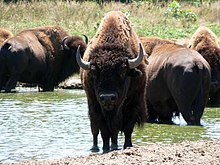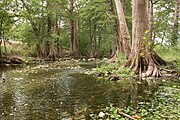Cibolo Creek
| Cibolo Creek | |
|---|---|
 Cibolo Creek in Boerne | |
 Map of the Cibolo Creek watershed | |
| Location | |
| Country | United States |
| State | Texas |
| Physical characteristics | |
| Source | Turkey Knob |
| • location | Boerne, Texas |
| • coordinates | 29°50′18″N 98°53′10″W / 29.83833°N 98.88611°W[1] |
| • elevation | 623 m (2,044 ft) |
| Mouth | San Antonio River |
• location | Helena, Texas |
• coordinates | 28°57′11″N 97°52′24″W / 28.95306°N 97.87333°W[1] |
• elevation | 93 m (305 ft) |
| Length | 154.497 km (96.000 mi) |
Cibolo Creek is a stream in
The stream is used for both recreational and cartographic purposes, serving as the eastern boundary of
Course
Cibolo Creek rises in the
Further downstream, the creek passes through
At its lower reaches, the terrain grows flatter and less rocky, supporting oak, mesquite and juniper.[10] As it meanders through Wilson and Karnes Counties, passing Zuehl, New Berlin, La Vernia, Sutherland Springs, and Cestohowa, Cibolo Creek meets with the San Antonio River near the ghost town of Helena.[2]
-
Cibolo Creek at Cibolo Nature Center
-
Cibolo Creek in Boerne, Texas
-
Cibolo Creek in Universal City, Texas
-
Cibolo Creek atIH-10 near Zuehl, Texas
Watershed
The drainage basin of Cibolo Creek is located in the lower reaches of the Cretaceous Glen Rose Formation along the southeastern edge of the Edwards Plateau. Many springs located in the upper and middle reaches of the watershed engage in karst activity in the limestone prevalent below the surface,[11] forming such caves as Cascade Caverns[2] and Natural Bridge Caverns.[12] An exchange occurs between the stream and these numerous underground springs that serve as a recharge for the Edwards-Trinity aquifer system. This system provides drinking water for millions of people in the surrounding area. Near the recharge zone, distributaries of the creek have carved deep canyons in the landscape of the Texas Hill Country, forming what is known as the Cibolo Canyonlands. The Cibolo Nature Center claims 1,300 acres (5.3 km2; 2.0 sq mi) of the watershed, to protect the water quality from the hazards of rapid development and population growth.[3]
Several streams serve as distributaries and tributaries of Cibolo Creek, and are included in the watershed.
History

Prior to European settlement, Cibolo Creek was referred to as Xoloton by the

Also in 1836 at the time of the

In the late 1840s and early 1850s, the communities of Selma, Sutherland Springs, Boerne, La Vernia, and Bulverde were established along the creek.[18] Later on, Cibolo[10] Schertz,[27] and Universal City were founded.[28] These settlements dealt with torrential floods that cost many their homes and lives in later years. The destruction was prominently witnessed during the October 1998 Central Texas floods,[29] and four years later during the flood of July 2002. The San Antonio River Authority authorized $114,599 to help clean debris from the creek in 2003, hoping to improve water quality.[30] Above-average levels of bacteria have been found in certain areas of the creek, leading to such initiatives as the Upper Cibolo Watershed Protection plan, which began in 2010.[31] Another plan to create a Cibolo Reservoir near Stockdale aimed to control flooding and provide fresh water met fierce opposition from local citizens concerned about the destruction of historic sites along the creek, and the loss of taxable land.[32]
Recreation
Several areas along the creek have been established for recreational use. Boerne City Park provides trails for hiking, nature walks and horseback riding, and is a part of the larger Cibolo Nature Center.
Several locations are available for fishing. According to
Climate
The climate in this area is characterized by hot, humid summers and generally mild to cool winters. According to the
See also
References
- ^ a b U.S. Geological Survey Geographic Names Information System: Cibolo Creek
- ^ a b c "An Analysis of Texas Waterways". Texas Parks and Wildlife. Texas Parks and Wildlife Department. June 16, 2008. Retrieved 15 March 2010.
- ^ a b c "Conservation". Cibolo.org. Cibolo Nature Center. 2006. Archived from the original on 15 July 2009. Retrieved 2 April 2010.
- ^ Pasley, Dave (September 21, 2009). "Cow Creek protests appeal of planning decision". The Boerne Star. Retrieved 16 March 2010.
- ^ "Cibolo Nature Center, Boerne". mysanantonio.com. Hearst Communications Inc. Archived from the original on 22 July 2011. Retrieved 17 May 2011.
- ^ "Cibolo Preserve" (PDF). University of Texas at San Antonio. Archived from the original (PDF) on 28 June 2011. Retrieved 17 May 2011.
- ^ a b Daniel, p. 139
- ^ Morgenthaler, p. 17
- ^ "About CCMA". Cibolo Creek Municipal Authority. 2003. Archived from the original on March 24, 2009. Retrieved 8 April 2010.
- ^ a b c Weinert, Willie Mae. "Cibolo, Texas". Handbook of Texas Online. Texas State Historical Association. Retrieved 16 March 2010.
- ^ Smith, A. Richard; George Veni. "Karst Regions of Texas". Texas Speleological Survey. University of Texas. Retrieved 3 April 2010.
- ^ George, Patrick (March 23, 2010). "50 years since discovery of largest-known caverns in Texas". Austin American-Statesman. Cox Media. Archived from the original on 26 March 2010. Retrieved 3 April 2010.
- ^ "2004 Master Plan Parks, Recreation and Open Space for Kendall County, Texas". Cibolo.org. Cibolo Nature Center. Archived from the original on 25 July 2011. Retrieved 3 April 2010.
- ^ "Balcones Creek". Handbook of Texas Online. Texas State Historical Association. February 22, 2010. Retrieved 3 April 2010.
- ^ "Martinez Creek". Handbook of Texas Online. Texas State Historical Association. February 22, 2010. Retrieved 3 April 2010.
- ^ "Santa Clara Creek". Handbook of Texas Online. Texas State Historical Association. February 22, 2010. Retrieved 3 April 2010.
- Handbook of Texas Online [1], accessed July 25, 2012.
- ^ a b c d "Cibolo Creek". Handbook of Texas Online. Texas State Historical Association. February 22, 2010. Retrieved 15 March 2010.
- ^ Foster, p. 22
- ^ Bandelier, p. 132
- ^ Tarpley, p. 46
- ^ Thonhoff, Robert (February 22, 2010). "Fuerte de Santa Cruz del Cíbolo". Handbook of Texas Online. Texas State Historical Association. Retrieved 16 March 2010.
- ^ Hardin, p. 25
- ^ Moore, p. 242
- Handbook of Texas Online [2], accessed July 14, 2012. Published by the Texas State Historical Association.
- ^ Steve Goodson, The Runaway Scrape
- ^ Smyrl, Vivian Elizabeth (February 22, 2010). "Schertz, Texas". Handbook of Texas Online. Texas State Historical Association. Retrieved 16 March 2010.
- ^ Duerson, Lawrence W. (February 22, 2010). "Universal City, Texas". Handbook of Texas Online. Texas State Historical Association. Retrieved 16 March 2010.
- ^ "Flood victims salvage what remains of homes". The Victoria Advocate. Associated Press. October 19, 1998. Retrieved 16 March 2010. [dead link]
- ^ "SARA Board approves Cibolo Creek clean-up project". San Antonio Business Journal. American City Business Journals, Inc. June 19, 2003. Retrieved 16 March 2010.
- ^ Byrne, Linda (March 11, 2010). "Cibolo cleanup programs protect watershed". Northwest Weekly. San Antonio Express-News. Retrieved 16 March 2010.
- ^ Kufus, Marty (February 1, 2000). "Citizens' group tells water planners of opposition to reservoir". Wilson County News Headlines. The Wilson County News. Retrieved 16 March 2010.
- ^ "Boerne City Park". Wild Texas. Shannon D. Moore. January 22, 2009. Retrieved 3 April 2010.
- ^ "Camp Bullis Outdoor Recreation Area". Fort Sam Houston MWR. Archived from the original on 31 March 2010. Retrieved 4 April 2010.
- ^ "Texas whitewater - Cibolo Creek, Comal Bexar County". Riverfacts.com. Stratus-Pikpuk, Inc. Retrieved 2 April 2010.
- ^ "Parks and Recreation". UniversalCityTexas.com. Universal City, Texas. Retrieved 4 April 2010.
- ^ "Jackson Nature Park, Stockdale". mysanantonio.com. Hearst Communications Inc. Archived from the original on 22 July 2011. Retrieved 16 May 2011.
- ^ "Water Body Records for Cibolo Creek". Texas Parks and Wildlife Department. March 1, 2010. Retrieved 14 March 2010.
- ^ Climate Summary for Cibolo Creek
Bibliography
- Bandelier, Adolph (1890). Hemenway southwestern archaeological expedition: Contributions to the history of the southwestern portion of the United States. J. Wilson and son.
- Daniel, Stephen Hartley (2004). Texas Whitewater. United States: Self-published.
- Foster, William (1995). Spanish expeditions into Texas, 1689-1768. Austin, Texas: University of Texas Press. ISBN 0-292-72489-6.
- ISBN 0-292-73086-1.
- Moore, Stephen (2002). Savage Frontier: Rangers, Riflemen, and Indian Wars in Texas. Vol. 1. Denton, Texas: University of North Texas Press. p. 242. ISBN 978-1-57441-235-2.
- Morgenthaler, Jefferson (October 3, 2005). Boerne: Settlement on the Cibolo. Great Texas Books. ISBN 978-1-932801-08-8.
- Tarpley, Fred (1980). 1001 Texas Place Names. Austin, Texas: University of Texas Press. ISBN 0-292-76016-7.
External links
- Cibolo Creek from the Handbook of Texas Online




